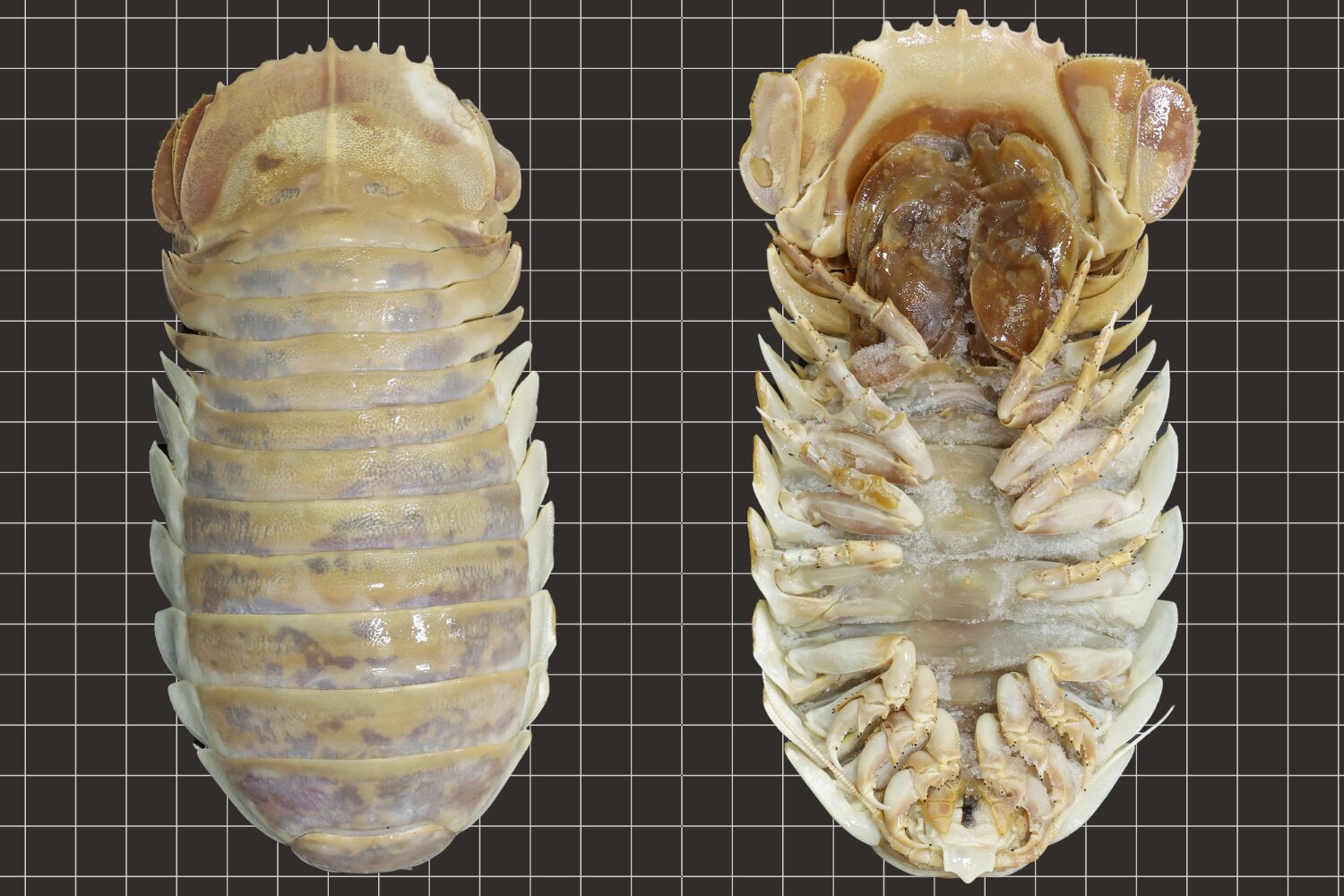Researchers have identified a new species of Bathonymus, the famous genus of deep-sea isopods whose viral internet fame has made them the most famous aquatic crustacean since Sebastian in The Little Mermaid.
There are about 20 living species of Bathonymus, a mysterious and primitive group that inhabits the ocean’s benthic zone—its deepest reaches that are rarely explored in person. Isopod crustaceans are only distantly related to their more familiar decapod relatives, the crab, shrimp, and lobster.
Publication of their results in the Journal of Natural Historya group of Taiwanese, Japanese and Australian researchers unveil the newest creature on this list: B. yucatanensis, a new species that’s about 26 cm long, about 2,500% larger than the common wood louse.
Deep-sea isopods belong to the same group that includes land isopods, variously known as woodlice, pillbugs, and roly polys, which feed on decaying matter and are probably familiar to anyone who’s picked up a rock or been digging around in the garden. In fact, they look quite similar, apart from their extraordinary size – the largest of them grow to almost 50 centimeters. And just like the wood louse, while they might look a little scary, they’re completely harmless to humans.
Their odd features and unusual dimensions have spawned endless memes and a range of products celebrating their lovable weirdness, from stuffed animals to phone cases.
This find of B. yucatanensis brings another addition to the isopod pantheon, bringing the total number of known Bathonymus species in the Gulf of Mexico to three – B. giganteus was described in 1879 and B. maxeyorum was described in 2016.
It was originally thought to be a variation of B. giganteus, one of the largest deep-sea isopods. However, closer inspection of the specimen, which was caught in a baited trap in the Gulf of Mexico off the Yucatán Peninsula at around 600 to 800 meters in 2017, revealed a number of unique characteristics.
“B. yucatanensis is morphologically distinct from both B. giganteus and B. maxeyorum,” the authors claim.
The individual kept by the Enoshima Aquarium in Japan differed subtly from its relatives. “Compared to B. giganteus, B. yucatanensis has slimmer body proportions and is shorter overall… and the pereopods [thoracic limbs] It also has longer antennae. The two species have the same number of Pleotelson spines. These spines protrude from the crustacean’s tail end.
‘Bathynomus giganteus was discovered over a century ago and more than 1,000 specimens have been examined without any evidence of a second species with the same number of pleotelsonic spines having been found to date,’ they add. “A cursory examination using only Pleotelson spines could easily result in specimens of B. yucatanensis being misidentified as B. giganteus.”
“Compared to B. maxeyorum, the most striking feature is the number of Pleotelson spines — 11 spines in B. yucatanensis versus 7 in B. maxeyorum.” The mottled, creamy yellow color of the shell further distinguished it from its grayer relatives.
To be sure, the scientists performed a molecular genetic analysis comparing B. giganteus and B. yucatanensis. “Based on the different sequences of the two genes (COI and 16S rRNA), coupled with differences in morphology, we identified it as a new species,” they write. The family tree they constructed showed B. yucatanensis to be the most closely related to B. giganteus.
“B. giganteus is actually the closest species to B. yucatanensis,” the authors claim. “This indicates that the two species likely shared a common ancestor. In addition, there may be other undiscovered species of Bathynomus in the tropical western Atlantic.”
The paper also clarifies that South China Sea specimens identified as B. kensleyi are in fact B. jamesi. B. kensleyi is restricted to the Coral Sea off the coast of Australia.
“It is becoming increasingly clear that Bathynomus species can be extremely similar in overall appearance and that there is a long history of species misidentification in the genus,” the authors warn.
They note that these newly introduced species distinctions have conservation implications. “Some Bathynomus species with commercial potential have become targets of deep-sea trawling,” they say. While giant isopods are exploited only sporadically, “Knowing exactly which species are being caught is important to the management of the Bathynomus fishery.”
Study reveals the first genome of deep-sea crustaceans
A new species of Bathynomus Milne-Edwards, 1879 (Isopoda: Cirolanidae) from the southern Gulf of Mexico with a redescription by Bathynomus jamesi Kou, Chen and Li, 2017 off Pratas Island, Taiwan, Journal of Natural History (2022). DOI: 10.1080/00222933.2022.2086835
Provided by Taylor & Francis
Citation: New Deep Sea Giant Isopod Discovered in Gulf of Mexico (2022, August 9) Retrieved August 10, 2022 from https://phys.org/news/2022-08-giant-deep-sea-isopod-gulf-mexico. html
This document is protected by copyright. Except for fair trade for the purpose of private study or research, no part may be reproduced without written permission. The content is for informational purposes only.
#giant #sea #isopod #discovered #Gulf #Mexico


Leave a Comment